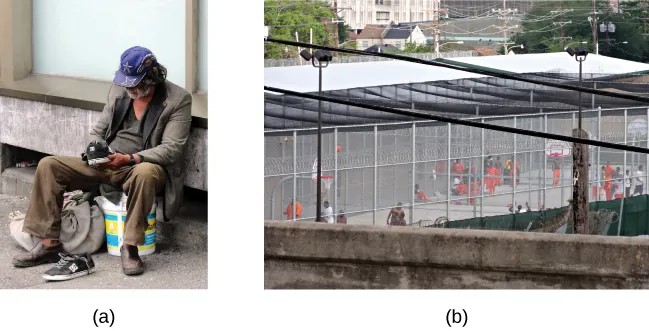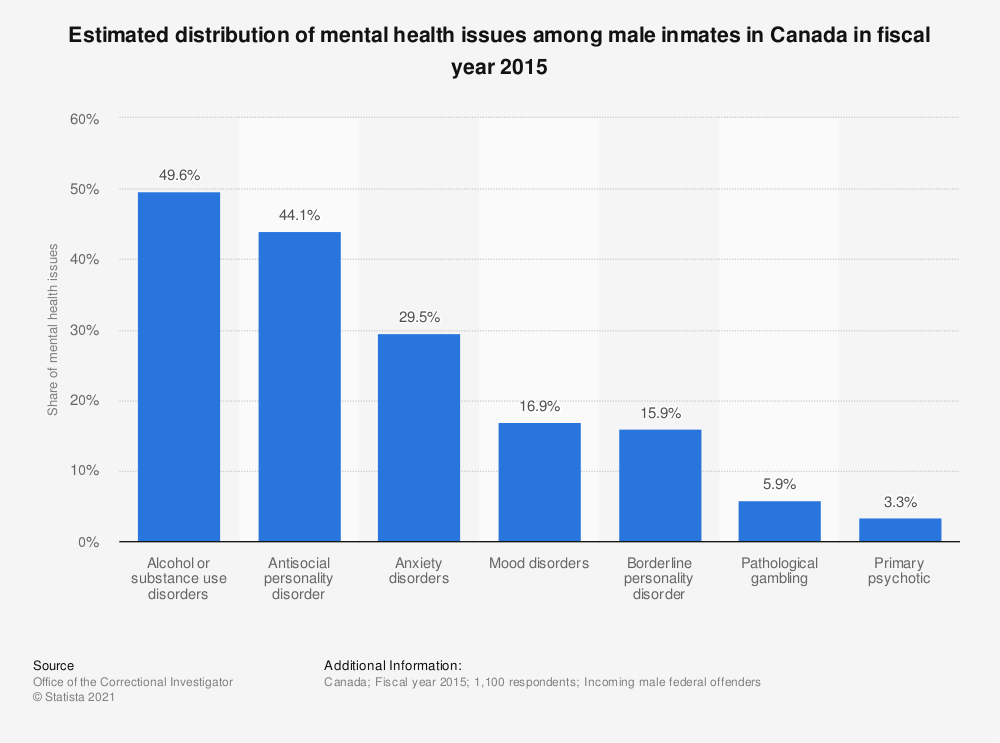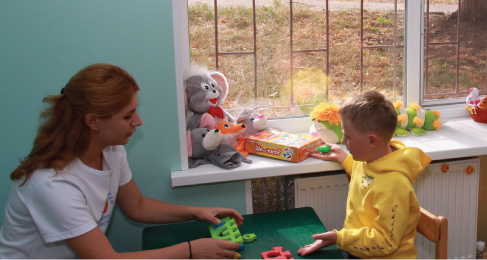History of Treatment
Learning Objectives
By the end of this section, you will be able to:
- Explain how people with psychological disorders have been treated throughout the ages
- Discuss deinstitutionalization
- Discuss the ways in which mental health services are delivered today
- Distinguish between voluntary and involuntary treatment
Before we explore the various approaches to therapy used today, let’s begin our study of therapy by looking at how many people experience mental illness and how many receive treatment. According to data compiled from the World Health Organization (WHO) and the Institute for Health Metrics and Evaluation (IHME), in 2017 approximately “792 million people lived with a mental health disorder” worldwide. It is worth nothing that this data is not perfect, with many cases unreported in lower-income countries (Ritchie & Roser, 2018). In 2017, over 5 million Canadians sought help, or felt that they needed help, for their mental health. Over 1 million of those Canadians reported having their needs unmet, with some suggesting that they preferred to “manage their needs on their own” (Statistics Canada, 2019). Common barriers for receiving treatment include affordability, not knowing where to get help, cultural and language barriers, and excessive wait times (Moroz, Moroz, & D’Angelo, 2020; Statistics Canada, 2019).
Children and adolescents also receive mental health services. According to the Mental Health Commission of Canada (MHCC, 2021), approximately 1.2 million children and youth are effected by mental illness, with a staggering jump up to 7.5 million by the age of 25. Lack of access and long wait-times were reported as the most common challenges for children in need of treatment (MHCC, 2020). Several opportunities to improve mental health care access have been proposed, including: coherent policy across jurisdictions and institutions, workforce development (in early childhood education), and increased parental supports (MHCC, 2020).
Considering the many forms of treatment for mental health disorders available today, how did these forms of treatment emerge? Let’s take a look at the history of mental health treatment from the past (with some questionable approaches in light of modern understanding of mental illness) to where we are today.
Treatment in the Past
For much of history, the mentally ill have been treated very poorly. It was believed that mental illness was caused by demonic possession, witchcraft, or an angry god (Szasz, 1960). For example, in medieval times, abnormal behaviours were viewed as a sign that a person was possessed by demons. If someone was considered to be possessed, there were several forms of treatment to release spirits from the individual. The most common treatment was exorcism, often conducted by priests or other religious figures: Incantations and prayers were said over the person’s body, and she may have been given some medicinal drinks. Another form of treatment for extreme cases of mental illness was trephining: A small hole was made in the afflicted individual’s skull to release spirits from the body. Most people treated in this manner died. In addition to exorcism and trephining, other practices involved execution or imprisonment of people with psychological disorders. Still others were left to be homeless beggars. Generally speaking, most people who exhibited strange behaviours were greatly misunderstood and treated cruelly. The prevailing theory of psychopathology in earlier history was the idea that mental illness was the result of demonic possession by either an evil spirit or an evil god because early beliefs incorrectly attributed all unexplainable phenomena to deities deemed either good or evil.
From the late 1400s to the late 1600s, a common belief perpetuated by some religious organizations was that some people made pacts with the devil and committed horrible acts, such as eating babies (Blumberg, 2007). These people were considered to be witches and were tried and condemned by courts—they were often burned at the stake. Worldwide, it is estimated that tens of thousands of mentally ill people were killed after being accused of being witches or under the influence of witchcraft (Hemphill, 1966)
By the 18th century, people who were considered odd and unusual were placed in asylums (Figure 16.2). Asylums were the first institutions created for the specific purpose of housing people with psychological disorders, but the focus was ostracizing them from society rather than treating their disorders. Often these people were kept in windowless dungeons, beaten, chained to their beds, and had little to no contact with caregivers.

In the late 1700s, a French physician, Philippe Pinel, argued for more humane treatment of the mentally ill. He suggested that they be unchained and talked to, and that’s just what he did for patients at La Salpêtrière in Paris in 1795 (Figure 16.3). Patients benefited from this more humane treatment, and many were able to leave the hospital.

In the 19th century, Dorothea Dix led reform efforts for mental health care in the United States (Figure 16.4). She investigated how those who are mentally ill and poor were cared for, and she discovered an underfunded and unregulated system that perpetuated abuse of this population (Tiffany, 1891). Horrified by her findings, Dix began lobbying various state legislatures and the U.S. Congress for change (Tiffany, 1891). Her efforts led to the creation of the first mental asylums in the United States.

Despite reformers’ efforts, however, a typical asylum was filthy, offered very little treatment, and often kept people for decades. At Willard Psychiatric Center in upstate New York, for example, one treatment was to submerge patients in cold baths for long periods of time. Electroshock treatment was also used, and the way the treatment was administered often broke patients’ backs; in 1943, doctors at Willard administered 1,443 shock treatments (Willard Psychiatric Center, 2009). (Electroshock is now called electroconvulsive treatment, and the therapy is still used, but with safeguards and under anesthesia. A brief application of electric stimulus is used to produce a generalized seizure. Controversy continues over its effectiveness versus the side effects.) Many of the wards and rooms were so cold that a glass of water would be frozen by morning (Willard Psychiatric Center, 2009). Willard’s doors were not closed until 1995. Conditions like these remained commonplace until well into the 20th century.
Starting in 1954 and gaining popularity in the 1960s, antipsychotic medications were introduced. These proved a tremendous help in controlling the symptoms of certain psychological disorders, such as psychosis. Psychosis was a common diagnosis of individuals in mental hospitals, and it was often evidenced by symptoms like hallucinations and delusions, indicating a loss of contact with reality. Then in 1963, Congress passed and John F. Kennedy signed the Mental Retardation Facilities and Community Mental Health Centers Construction Act, which provided federal support and funding for community mental health centers (National Institutes of Health, 2013). This legislation changed how mental health services were delivered in the United States. It started the process of deinstitutionalization, the closing of large asylums, by providing for people to stay in their communities and be treated locally. In 1955, there were 558,239 severely mentally ill patients institutionalized at public hospitals (Torrey, 1997). By 1994, by percentage of the population, there were 92% fewer hospitalized individuals (Torrey, 1997).
Mental Health Treatment Today
Today, there are community mental health centers across the nation. They are located in neighborhoods near the homes of clients, and they provide large numbers of people with mental health services of various kinds and for many kinds of problems. Unfortunately, part of what occurred with deinstitutionalization was that those released from institutions were supposed to go to newly created centers, but the system was not set up effectively. Centers were underfunded, staff was not trained to handle severe illnesses such as schizophrenia, there was high staff burnout, and no provision was made for the other services people needed, such as housing, food, and job training. Without these supports, those people released under deinstitutionalization often ended up homeless. Even today, a large portion of the homeless population is considered to be mentally ill (Figure 16.5). Statistics show that between 25%-50% of the homeless population in Canada suffer from mental illness (Homeless Hub, 2016) .

Another group of the mentally ill population is involved in the corrections system. According to a 2006 special report by the Bureau of Justice Statistics (BJS), approximately 705,600 mentally ill adults were incarcerated in the state prison system, and another 78,800 were incarcerated in the federal prison system. A further 479,000 were in local jails. According to the study, “people with mental illnesses are overrepresented in probation and parole populations at estimated rates ranging from two to four times the general population” (Prins & Draper, 2009, p. 23). The Treatment Advocacy Center reported that the growing number of mentally ill inmates has placed a burden on the correctional system (Torrey et al., 2014). In Canada, it is estimated that approximately 30% of inmates suffer from mental illness (Brink, Doherty, & Boer, 2001); see the graph below for a breakdown of disorders in a sample of 1100 male offenders (Statista, 2021).

Today, instead of asylums, there are psychiatric hospitals run by state governments and local community hospitals focused on short-term care. In all types of hospitals, the emphasis is on short-term stays, with the average length of stay being less than two weeks and often only several days. Usually individuals are hospitalized only if they are an imminent threat to themselves or others. Most hospitals have mental health services and can accommodate both inpatient and outpatient care. Unfortunately, unless a patient is cared for in hospital, psychological care must be paid for out-of-pocket or by a third-party insurance provider (Canadian Civil Liberties Association, 2021).
Most people suffering from mental illnesses are not hospitalized. If someone is feeling very depressed, complains of hearing voices, or feels anxious all the time, he or she might seek psychological treatment. A friend, spouse, or parent might refer someone for treatment. The individual might go see his primary care physician first and then be referred to a mental health practitioner.
Some people seek treatment because they are involved with the provinces child welfare services—that is, their children have been removed from their care due to abuse or neglect. The parents might be referred to psychiatric or substance abuse facilities and the children would likely receive treatment for trauma. If the parents are interested in and capable of becoming better parents, the goal of treatment might be family reunification. For other children whose parents are unable to change—for example, the parent or parents who are heavily addicted to drugs and refuse to enter treatment—the goal of therapy might be to help the children adjust to foster care and/or adoption (Figure 16.9).

Some people seek therapy because the criminal justice system referred them or required them to go. For some individuals, for example, attending weekly counseling sessions might be a condition of parole. If an individual is mandated to attend therapy, she is seeking services involuntarily. Involuntary treatment refers to therapy that is not the individual’s choice. Other individuals might voluntarily seek treatment. Voluntary treatment means the person chooses to attend therapy to obtain relief from symptoms.
Psychological treatment can occur in a variety of places. An individual might go to a community mental health center or a practitioner in private or community practice. A child might see a school counselor, school psychologist, or school social worker. An incarcerated person might receive group therapy in prison. There are many different types of treatment providers, and licensing requirements vary among the provinces and territories. Besides psychologists and psychiatrists, there are clinical social workers, marriage and family therapists, and trained religious personnel who also perform counseling and therapy.
Finding treatment sources is also not always easy: there may be limited options, especially in rural and northern areas, and low-income urban areas; waiting lists; poor quality of care available for indigent patients; and financial obstacles such as co-pays, deductibles, and time off from work. Often, primary care physicians and law enforcement are the first-line mental health providers (Ivey, Scheffler, & Zazzali, 1998), although they do not have the specialized training of a mental health professional, who often would be better equipped to provide care. Availability, accessibility, and acceptability (the stigma attached to mental illness) are all problems in rural areas. Approximately two-thirds of those with symptoms receive no care at all (U.S. Department of Health and Human Services, 2005; Wagenfeld, Murray, Mohatt, & DeBruiynb, 1994). In 2007, the Canadian government created the Mental Health Commission of Canada tasked with developing a national mental health strategy, reducing stigma and discrimination, and supporting research on topics such as mental health and homelessness.
Thinking Globally about Mental Health and its’ Treatment
“What I’ve found fascinating about mental illness is that it is always defined by culture, and therefore culture comes to shape the profession of psychiatry and to define what we mean by madness,” – Emmanuel Akyeampong, professor of history and of African and African American studies.
Ken Gewertz, Harvard News Office, 2006
Much of the history described in the sections above comes from Western European societies; Do some research online to see what you can find out about the history of mental illness in various cultures and societies to see how it may have differed.
refers to therapy that is not the individual’s choice
the person chooses to attend therapy to obtain relief from symptoms

